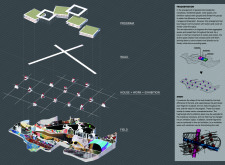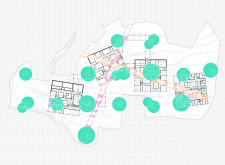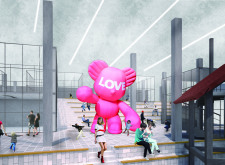5 key facts about this project
The function of Playground Village is multifaceted, accommodating various activities that include residential, artistic, and commercial uses. The design promotes a blend of working and living environments, allowing artists to be immersed in their practice while engaging with the public. By incorporating spaces for exhibitions, workshops, and communal events, the project fosters continuous interaction between artists and visitors, encouraging spontaneous connections and exchanges of ideas.
Key elements of the project include a series of interconnected buildings and open outdoor spaces, which are arranged in a way that promotes exploration and interaction. The layout takes advantage of the site's topography, creating a series of levels that guide visitors through different areas. This approach enhances the experience of the village, allowing users to discover various functions and artworks as they navigate the space. Public artworks, including thoughtfully placed sculptures, serve both as focal points and conversation starters, enriching the communal atmosphere.
The materiality of Playground Village plays a critical role in both its aesthetic and environmental sustainability. Concrete forms the structural backbone, providing durability and solidity to the buildings. Glass is strategically incorporated to foster transparency and a visual connection between indoor and outdoor spaces, effectively blurring the boundaries between architecture and nature. Green roofs not only provide ecological benefits by supporting local biodiversity but also offer inhabitants a chance to engage with nature in an urban context. Steel elements bring both strength and flexibility to the designs, allowing for innovative shapes and functional spaces that cater to various artistic needs.
Unique to the Playground Village is the emphasis on creating a participatory artistic environment, where the built form directly engages with the landscape. The layout encourages visitors to meander through the village, discovering art installations that are meant to be experienced in situ. This engagement allows art to become an interactive experience, rather than a distant observation, thereby deepening the connection between the audience and the creative process.
The project embodies contemporary architectural ideas that reflect a shift towards holistic design, where architecture serves broader social and environmental purposes. Its design encourages a dialogue between art and experience, and it sees architecture not just as a container for activities but as an active participant in fostering community and creativity.
For those keen to delve deeper into the Playground Village's architectural plans, sections, and design ideas, further exploration of the project's presentation is encouraged. This offers an opportunity to appreciate the intricate balance of functionality and artistry that defines this unique architectural endeavor.


























